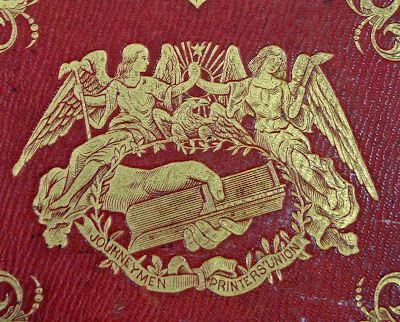Printers have long been at the forefront of the struggle for workers' rights. From the dawn of the American republic, they have organized locally and regionally to protect their rights, privileges, and wages. Printers' unions actually pre-date better-known organizations like the United Auto Workers, the Teamsters, and the American Federation of Teachers by many years, as revealed by a recent gift from J. B. Dobkin.
At a glance, the 1850 edition of Robinson Crusoe by Daniel De Foe looks like just another one of the hundreds of editions of the classic work produced in the United States in the nineteenth century. But look closely, and notice the handsome device on the cover of the elaborately decorated binding. Beneath a tangle of iconography that includes angels holding hands, a radiant star, a bald eagle, and a laurel wreath, is something immediately recognizable to anyone who has set type: a hand grasping a composing stick. (Actually, if you look very closely, you'll see “Stick & Rule" engraved on the edge of the stick. We learned that this is an obsolete name for the composing stick used until the early twentieth century.) In the ribbon below the composing stick is the name “Journeymen Printers' Union." That organization, based in Philadelphia, is credited as the publisher on the title page, and one of its members edited this edition. The reader has only to turn another page to learn why the Union issued the book themselves, rather than one of the publishers that its members worked for.
According to a two-page “Advertisement," the union was founded on June 27, 1850, “to improve the condition of the craft." One thing they did to achieve that end was to adopt a scale of prices — what we would call a minimum wage — for the various kinds of work its members did in newspaper offices, and in book and job offices. The scale went into effect on September 2, and while the majority of employers conceded to it, some employers refused to comply, which led to the dismissal of nearly one hundred union members from their jobs. The union went on strike against those employers, and decided to support the unemployed members by printing and selling this new edition of Robinson Crusoe. Our copy is from the third edition, following a first edition of 1,000 copies and a second edition of 2,000 copies. Ultimately, five editions totaling 17,000 copies were issued, but the venture cost the union money. Even though it was unprofitable, the venture was a great exercise in solidarity and fraternity, as the strike went on for nearly six months, and only a handful of members “left the cause to which they had solemnly pledged themselves and subscribed their names. These, in printers' language, are denominated rats, and as such, no doubt, they will find snares set by themselves at every opening to their lurking places."
As the strike drew to a close, a meeting was held on December 2, 1850, in New York City, bringing together the Journeymen Printers' Union and representatives from similar unions in New York, New Jersey, Maryland, and Kentucky to form what would become the National Typographical Union, which was formally organized in Cincinnati, Ohio, on May 5, 1852. Philadelphia's journeymen's union became the Philadelphia Typographical Union No. 2.
The future of organized labor must have seemed bright. We wonder if those printers of 1850 would be surprised to know that the struggle continues, 155 years later, “to redeem men from the virtual slavery into which they have been reduced by the unrighteous ascendency of capital."



2 comments:
That's a really great story and a sharp looking insignia.
Who knew it was the printers that started a movement. Sounds like history repeats itself.
Post a Comment